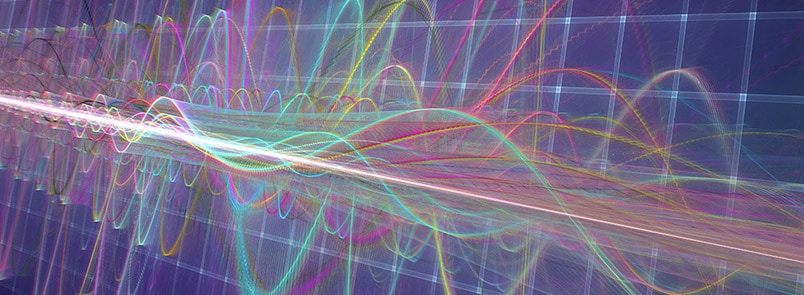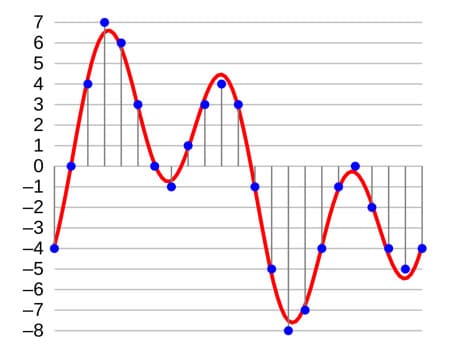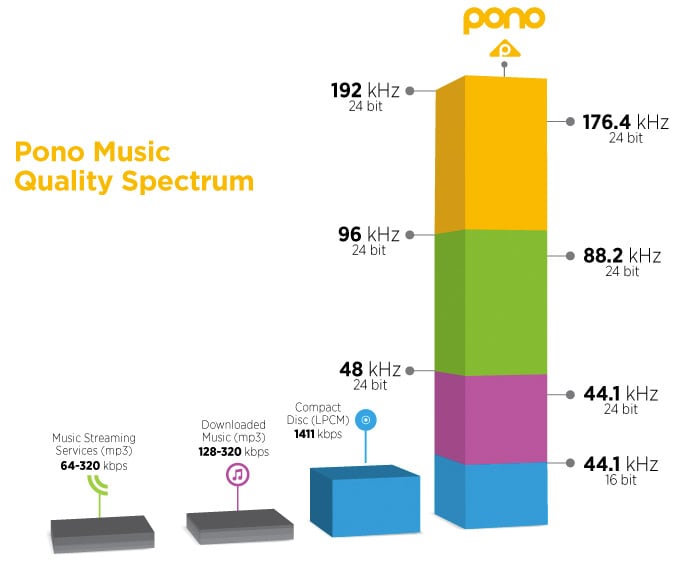High-Resolution Audio and the Future of Portable Players
By Benjamin Miller, Mouser Electronics

The process of capturing sound digitally and reproducing it for human consumption has been fine-tuned over the decades. Unfortunately, lossy compression, a technology that reduces the size of files allowing music to be portable, has made the “degraded sound” of MP3s more than acceptable to ears of the younger generation that grew up with them. A Compact Disc (CD) has much higher quality sound than MP3s. On the “B-side” of audio development is high-resolution, better-than-CD-quality audio. This new paradigm of music quality is allegedly clearer than that of the compact disc (standard-definition files), and provides more space for the music to breathe. Whether high-res audio becomes mainstream or not, more people could be soon moving toward a “middle ground” of CD quality or standard-definition music, when it becomes as convenient as an MP3.
Even though MP3 quality sound is acceptable to many, the need for better, high-definition audio is contended by musicians, audio engineers, and hi-fi aficionados. Since the early 90s, when CDs began to take over the market from vinyl records and cassettes, listeners have argued over whether digital media can accurately capture the important qualities of a live music performance. Most of the criticism has been aimed at lossy portable files that are heavily compressed for quicker download. There is a push among musicians and producers in the music industry to release high-resolution audio files for portable consumption. This is an improvement over storing music in compressed file formats, but it also leapfrogs over standard-definition files (CD-quality files) altogether. CD quality is not the limit of audio resolution, but better-than-CD resolution (high-definition) is costly and returns little improvement, which is an issue, especially if people see no need to buy their music at standard definition, much less high-resolution.
Considerations Related to Audio Quality
In order to discuss audio quality, one must first understand two main considerations. The first includes sample rate and bit-depth (see side bar for definitions of these and other terms). Both of these specifications are determined when a song is recorded. The current standard for CD quality has a sample rate of 44.1 kiloHertz (kHz) and a bit-depth of 16 bits.

Figure 1: Audio Sampling: Blue dots are samples of the red analog signal. Bit-depth is shown vertically, sample rate horizontally. Source: Wikipedia.org
The other consideration is file compression. The native bitrate of an audio file is the product of the sample rate and bit-depth for each channel of audio (where stereo counts as two channels). The bitrate of a file, however, is dependent on how it is compressed and encoded. Most audio files are compressed to fir on a portable device. An audio file is usually compressed and converted from a huge Waveform Audio File (WAVE) with a bitrate of 1411.4 kilobits per second (kbps) to a smaller file format like MP3 (with a maximum bitrate of 320 kbps), Vorbis, or Free-Lossless Audio Codec (FLAC). Software encoders do the compression, each using a different algorithm to decide what data can be removed without changing the audio significantly. For example, a Vorbis file at 128 kbps might sound better than an MP3 at the same bitrate because the Vorbis encoder uses a different algorithm to compress files. FLAC is a format known for efficient lossless compression and freedom from licensing costs; thus it has become somewhat synonymous with high-quality audio at a reasonable file size. Apple has their own formats: Advanced Audio Coding (AAC) for lossy compression on iPods (comparable to an MP3), Apple Lossless Audio Codec for lossless compression on Macs (comparable to FLAC), and Audio Interchange File Format (AIFF), an uncompressed file format that is comparable to WAVE).
Poor quality files have created a distaste for anything digital or portable among many audiophiles, while others have been preaching about resampling old masters and releasing music at a higher digital quality. Neil Young has led the charge for high-definition, losslessly-compressed music with his company Pono. The Pono music player plays 24-bit, 192kHz FLAC files, with bitrates ranging from 1411kbps to 9216 kbps. Recall that CDs offer about 16-bits at 44.1 kHz. Much of today’s music is recorded at a high resolution, but when digital recording was new, digital masters were recorded at CD-quality. Analog masters can be converted from tape to digital at the required spec for high-res audio, but nothing recorded digitally at 16 bits and 44.1 kHz will ever be “Pono quality.” If high-resolution catches on as Young wishes, more content will need to be originally produced at high resolution. The music industry has set out to create standards for what can be considered high-resolution1, but will music lovers buy into it?

Figure 2: A marketing piece for Pono comparing Pono specs to other music formats. Source: https://www.ponomusic.com/aboutus
Better quality content will only come when the consumer decides that the additional cost is worth the quality increase. Higher quality requires more storage space. A 64 gigabyte (GB) memory iPhone can hold a lot of 256 kbps MP3s, and consumers seem happy to listen to compressed music if it means fitting more content on their player. The Pono player also has 64 GB of memory, but the average 192 kHz, 24-bit FLAC (Pono-quality) file clocks in around 195 megabytes (MB)2. Comparatively, 44.1 kHz, 16 bit FLACs are only about 6.7 MB3. “Pono-quality” audio takes up almost 30 the space as a lossless CD-quality file. Of course, data storage is getting cheaper and physically smaller, so worry about the size of an audio file is temporary. But for now, such a small increase in perceived improvement requires taking up expensive space, probably too much for most music players or smartphones.
Players like the Pono also boast specialized hardware which claims “better sound for any file.” Unfortunately, this raises the cost of the player significantly. The Pono player is currently $399, and it’s an extra $300 for a good set of headphones and another $200 for a headphone amp to be able to hear the quality of a high-resolution album from the Pono store (~$20). But time has shown that audiophiles will spend more money on good-quality sound systems, right? Perhaps not, if they cannot tell the difference in sound quality after spending all the extra money.
Is High-Resolution Any Better Than the CD?
High-definition audio is not like high-definition video, where resolution differences become more obvious when displayed on larger screens. More bits per sample reduces quantization error. The benefit in 24-bit audio goes mainly to the audio engineer who can use it to combat noise in the recording process, creating more “space” in the music as a result of the increased headroom4. While an increase in bit depth is barely noticable to the end listener, the benefits of higher sample rates are close to non-existent. Applying some engineering principles, Nyquist’s Theorem says that in order to accurately sample a signal, the sample frequency must be greater than twice the frequency of the source signal. Human hearing tops out at 20 kHz, so 44.1 kHz is plenty; more than twice that value. Thus, it should theoretically capture the highest humanly audible pitch possible. This is why the standard has become CD-quality, and any higher sample rates capture only inaudible frequencies.5
An audio engineer may use higher sampling rates for a variety of reasons related to the mixing process; pitch correction and speed adjustment are a couple of examples. However, usually they will remove inaudible sounds with filters during the mastering process. So, to the end listener, bitrate and sampling rate both may provide only the tiniest improvement to the sound. And what is the cost for all that extra “space,” created by lowering the noise floor with a higher bitrate, between the instruments and those scientifically inaudible frequencies? Neil Young is charging an extra $10 for his high-res albums.
This discussion is of course not limited to the Pono player. As storage gets cheaper, more people may move to lossless files anyway. The heart of the matter is this: consumers have chosen convenience over quality. People compress their music to carry it around with them. Consumers do not notice or perhaps even care that the music sounds worse than on the CD they might have ripped it from. Rather than pushing high-resolution audio files on consumers, would Neil Young be doing a greater service to the music industry by trying to convince people to use losslessly compressed CD-quality files on their phones? Many consumers no longer buy CDs because it is much easier to download or stream from their phones. Better compression techniques combined with faster network speeds will allow music lovers to download FLACs quicker in the future, putting lossy compression out of business. Consumers can have better quality on their phones without spending the money for extraneous quality they cannot hear. In addition to better files, high quality hardware in a small form factor would be a worthwhile difference. The Pono allegedly plays CD-quality files better than a CD-player, but in a portable device due to its custom data converters. Setting aside all questionable science about high-resolution, that fact alone makes Pono a win for audio quality. Enabling one to fit the same amount of songs at CD-quality on a portable device that sounds as good as a stereo system is the best of both worlds.
When it comes to the sound of the music, we already have the best that we are going to get. It would be a waste of money to buy high-resolution files, either because your equipment is not good enough or your ears cannot tell the difference. For those who think high-resolution is worth the cost, there are plenty of players made for “golden ears.” The best part of digital audio is that each and every person gets to choose how much quality they want to pay for, and now there are simply more options for those who want to carry better fidelity music in their pockets.
For more articles and information about sound technology, check out the Audio Applications site, which includes an article by Barry Manz which covers compression in the context of wireless audio.
Sources
- http://www.digitaltrends.com/music/industries-unite-standard-definition-hi-res-audio/
- https://www.ponomusic.com/
- http://dsd-guide.com/size-comparison-chart-various-formats-dsd-wav-flac-mp3
- http://www.soundonsound.com/sound-advice/q-do-i-really-need-24-bit-recording
- https://xiph.org/~xiphmont/demo/neil-young.html
Definitions
Analog – Audio in the form of continuous waveforms for varying frequency and amplitude, as captured by magnetic tape and vinyl records. Sound’s natural habitat.
Digital – Audio in the form of discrete binary samples, as captured and stored by computers.
Sample Rate – How many times per second a waveform is sampled, or captured, by an analog-to-digital converter (ADC). A sample captures the amplitude (loudness) of a wave. 44.1 kHz is the CD quality standard sample rate.
Bit-depth – The size of each sample in bits. In practice, the more bits written every sample, the higher precision the sample can capture. Analogous to the number of pixels captured by a video camera; more bits, more detail. The CD standard is 16-bits per sample.
Bitrate – The number of bytes written in the audio file per second of sound. Uncompressed bitrate is the product of the sample rate times the bit-depth (double that for stereo). An uncompressed PCM (the format CDs are written in) file is 1411.4 kilobits per second (kbps). For compressed formats, bitrate can vary depending on the size of the file desired. Example bitrates include 128 kbps for a poor quality MP3 and 320 kbps for the best quality MP3.
Compression – Minimizing the size of an audio file. This is done by audio codecs, converting the file into a new format. Codecs can be lossless or lossy.
Lossless – Audio files are compressed by means in which all of the original data is included, without sacrificing some data for disk space. Examples include the Apple Lossless Audio Codec (ALAC) and the Free Lossless Audio Codec (FLAC).
Lossy – Files are compressed by removing data. Lossy codecs have algorithms which can remove data that human ears will likely not miss, but too much compression can make the audio sound thin or incomplete. Examples include MP3 and Vorbis.